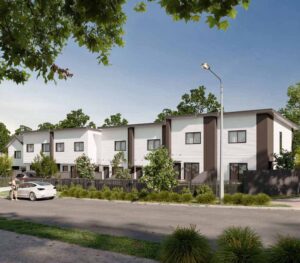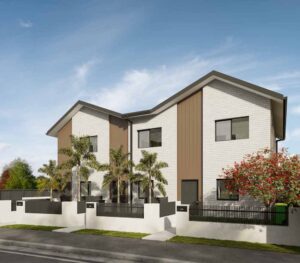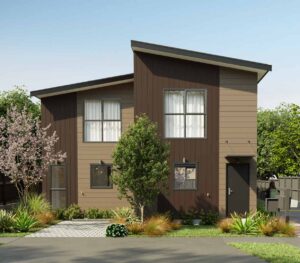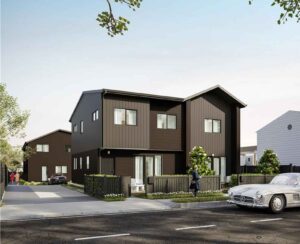Cross Lease | Everything you need to know about cross lease properties!

What is a Cross-Lease Property?
A cross lease is one of the formal structures of land ownership in New Zealand. Under this arrangement, multiple people jointly own a section of land, and the homes built on that land are leased from the joint owners, typically for 999 years.
For example, imagine two flats built side by side on a cross-lease title. If you buy one of those flats, you will:
- Jointly own all the land with the other flat owner.
- Own the buildings on your exclusive part of the land (your house).
- Hold a long-term lease for the portion of land you use exclusively.
Essentially, you and your neighbour collectively own the land and then lease your portion from one another.
What are the risks involved in buying a Cross-Lease property?
While cross leases were once the bees’ knees, they’ve become less desirable compared to freehold properties in today’s market.
The main reason? Restrictions.
Because several people jointly own the land, any significant changes to your property often require your neighbour’s consent.
For example:
- Alterations to the footprint of the property (e.g., rebuilding, extensions).
- Smaller changes like turning a window into French doors or extending a deck.
If your neighbour doesn’t agree, your plans can be blocked altogether.
This is why many owners choose to convert their cross lease into a fee simple title, to gain more freedom over their property (more on how that works below).
Buying & Selling a Cross-Lease
Buying a Cross-Lease Property
If you own a cross-lease property, it’s wise to maintain a good relationship with the other owners. Their consent is required for many changes, and there’s no guarantee approval will be given freely.
When buying, carefully weigh up the limitations of the lease against how you intend to use or develop the property. Make sure your plans align with what’s allowed under the lease.
It’s also important to clarify the exclusive use areas versus the common areas. These are usually marked on the flats plan and by fences, lawns, or concrete divisions.
However, in some cases, the boundaries are unclear or even fully shared, which can lead to disputes between owners.
Selling a Cross-Lease Property
When selling, accuracy is crucial. If the dwelling’s footprint does not match what’s shown on the flats plan attached to the title, a buyer may “requisition the title.”
In this case, the purchaser can require you (the vendor) to amend the title, which can be costly. If you refuse, the buyer has the legal right to cancel the sale and purchase agreement altogether.
Pros of Cross-Lease Title
Buying a cross-lease is not all bad. There are several positives of buying a property under a cross-lease title.
- Lower Purchase Price – Cross-lease properties are usually cheaper than freehold, making them attractive to first-home buyers or budget-conscious investors.
- Long Lease Term – Most leases are for 999 years at a nominal rent (like 10 cents a year), so you don’t have to worry about the lease expiring.
- Shared Land Costs – Since the land is jointly owned, costs like fencing, driveways, or common area maintenance may be shared among owners.
- Good Entry into Desirable Areas – In places like Auckland’s North Shore, cross-lease properties provided affordable housing in otherwise high-demand suburbs.
- Similar Benefits to Freehold – You still effectively “own” your home and have long-term rights to occupy your exclusive-use area.
Cons of Cross-Lease Property
- Restrictions on Changes – Any alteration to your home’s footprint (extensions, rebuilds, or even adding a deck) usually requires the written consent of all other cross-lease owners.
- Potential for Disputes – Shared ownership of the land means disagreements can arise over changes, boundaries, or the use of common areas.
- Complicated Sales – If your home’s footprint doesn’t match what’s shown on the flats plan, buyers can object (“requisition the title”) and even cancel the sale.
- Less Market Appeal – Cross-lease properties are generally less desirable than freehold, which can reduce buyer interest and affect resale value.
- Conversion Costs – Many owners convert cross-lease titles to freehold (fee simple) for more freedom, but this process can be complex and expensive.
Cross-Lease Title Conversion
If you’re thinking about converting your cross-lease title to fee simple, you’re heading in the right direction. There are several reasons pushing this decision. Some of the most common reasons for them are:
- Increase in Market Value – Properties with fee simple titles typically achieve a higher sale price and uplift in land value.
- Simpler Management – Fee simple titles are easier to administer since there’s no need to coordinate with co-owners.
- Freedom to Renovate – You can renovate, extend, or rebuild without needing written consent from your neighbours.
- Full Control – As the sole landowner, you have complete authority over your property.
- Rectifying a Defective Title – Cross leases are often seen as defective titles, so conversion resolves this issue.
- Avoiding Disputes – Converting removes the potential for conflicts caused by personality differences between co-owners.
Process of Converting Cross-Lease to Fee Simple
Converting a cross-lease title to fee simple is not a quick task; it typically takes 8–9 months to complete.
Amber’s advice, from a surveyor’s perspective, is to start by discussing your plans with your neighbours. If everyone agrees, the process is much smoother.
Here’s a step-by-step outline of how it works:
Step 1: Engage a Surveyor – A surveyor visits your property to assess the land, existing dwellings, and services.
Step 2: Apply for Resource Consent – Submit an application to the local council. (Note: Council may require certain works to be carried out before granting consent, depending on your property.)
Step 3: Survey & Legal Documentation – Once consent is granted, the surveyor provides the plans to your solicitor, who prepares the necessary legal documents.
Step 4: Lodgement with LINZ – The documents and plans are submitted to Land Information New Zealand (LINZ), who then issue separate fee simple titles for you and your neighbours.
What is the cost of converting a Cross-Lease to a Fee Simple?
There’s no fixed fee for converting one title to another, the cost depends on factors such as:
- Location
- Size of the cross lease being converted
As a ballpark estimate, here’s what you can expect for a 2-lot cross-lease conversion:
- Auckland: $38,000 – $40,000
- Christchurch: $20,000 – $22,000
These figures generally cover surveying fees, legal fees, and council LIMs.
At first glance, you might think: “That’s a lot of money … is it worth it?”
The answer depends on the value uplift:
- Christchurch – The uplift roughly equals the spend. If you spend $20k, your property value increases by about $20k.
- Auckland – You often double your money. A $40k conversion could increase your property’s value by around $80k.
This is especially true on the North Shore, where many cross-lease properties are located. In high-value suburbs like Takapuna, converting to fee simple can add significant value and improve market appeal.
You might also like to check out our article on “Freehold Property | What it is and what its pros and cons are?”
Do Both Parties End Up with Equal Land After Conversion?
A common misconception is that if there are two owners on a cross lease, each will receive half the land once the title is converted to fee simple.
In reality, that’s usually not the case.
When converting, the legal boundaries are typically based on the current “occupied areas” of the properties.
For example:
- X and Y own a 900m², 2-lot cross lease.
- The fence line reflects that X’s property covers 550m², while Y’s flat covers 350m².
- After conversion, Y doesn’t suddenly receive half (450m²). Instead, he gets the 350m² he already occupies, and X gets the 550m².
While both still own a share in the underlying land under the cross lease, the fee simple boundaries reflect actual occupation, not equal division.
Can Neighbours Negotiate?
Yes, neighbours can negotiate adjustments to boundaries before conversion. For instance, might Y ask X for a larger share?
But this requires cooperation. If Shirley says “no”, then Bob has no choice but to accept his current occupied area as his fee simple title.
That’s why good communication and neighbourly relationships are key when considering a cross-lease conversion.






